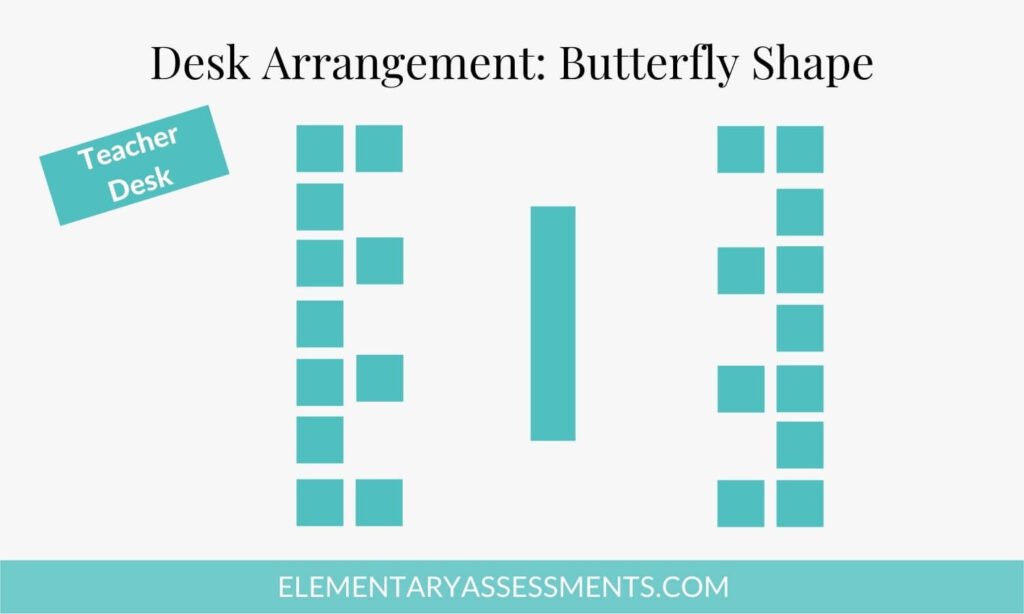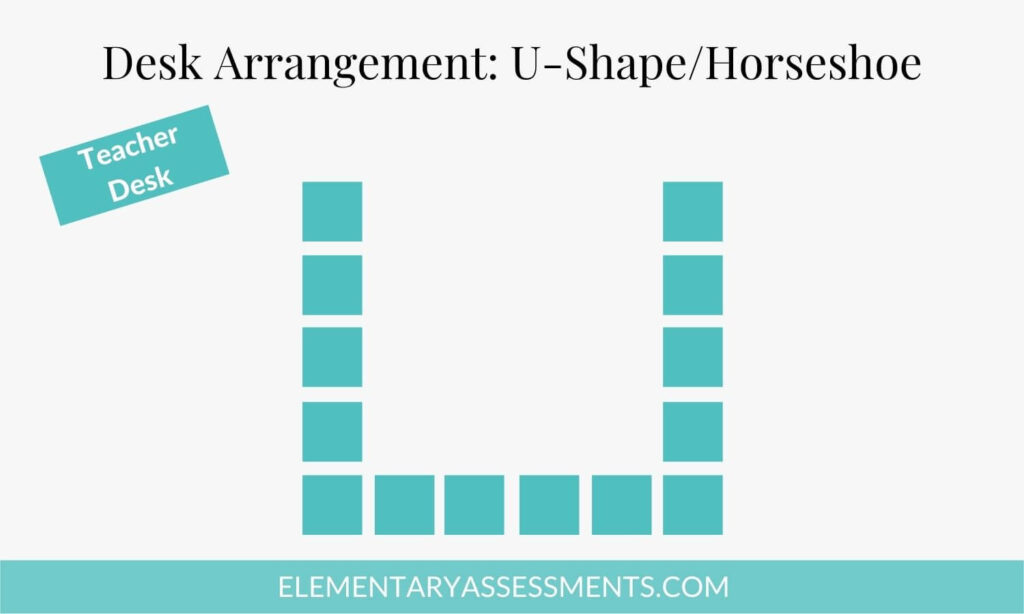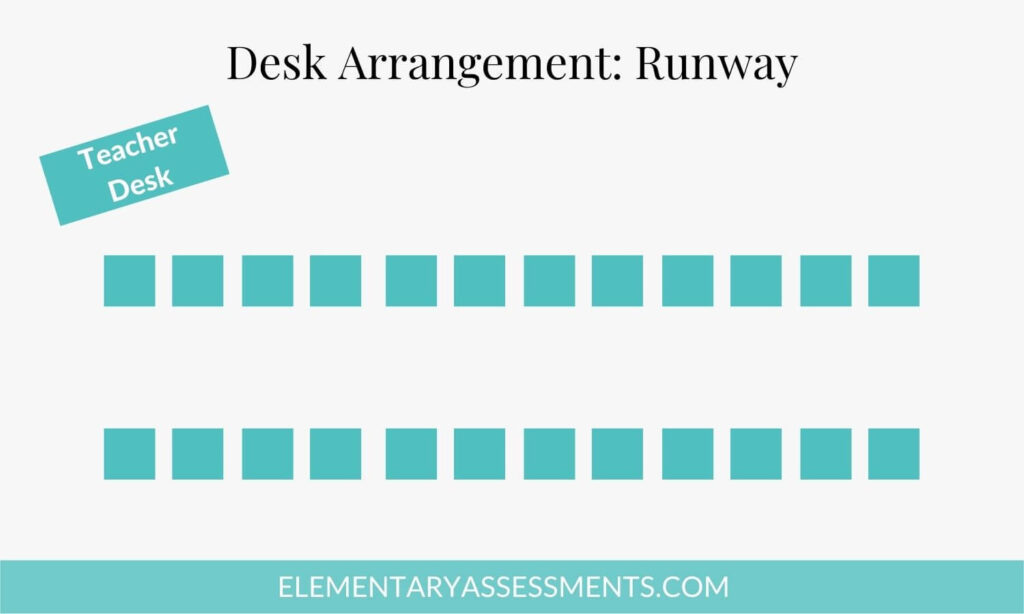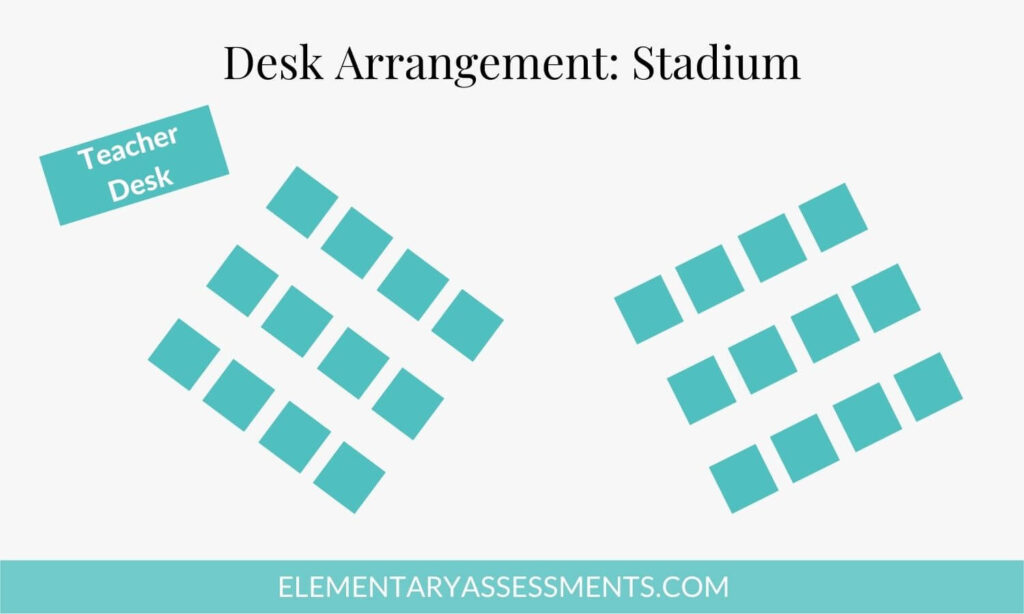Seeking ideas for different classroom desk arrangements to try?
If so, you’ve landed in the right place.
Here you’ll find the best classroom desk arrangements that fit a variety of learning and teaching styles.
As you’re experimenting with seating arrangements that are most effective for learning in your classroom, you’ll want to reference this guide.
The information and visuals will enable you to easily brainstorm the pros and cons of each layout.
What Is the Best Way to Arrange Desks In a Classroom?
The right seating arrangement helps to increase student engagement and prevents problem behaviors.
Yet, choosing how to arrange classroom desks depends on your preferences and teaching style.
Whether you have a class of less than 20 or a class of 28 students, explore the most commonly-used classroom desk arrangements to find the layout that works best for you and your students.
Related: essential classroom routines and procedures
Classroom Desk Arrangements
Following you will find examples of classroom desk arrangement ideas.
1. Pairs

The “pair up” arrangement involves placing students in pairs using a set of desks or a single bench.
It is also a common layout for science rooms that utilize tables instead of desks. The desks or tables can face forward or toward each other in groups of two.
This layout encourages students to work together but also allows them to work independently.
2. The Butterfly

With the butterfly, desks face toward one or two desks in the center, creating two E-shapes
This layout allows students to easily work independently or in small groups while the center desks encourage self-paced learning.
The teacher can observe students from the teacher’s desk and easily reach them in order to provide more guidance when needed.
3. Desks in Rows

A classroom desk arrangement for 20 students or more, this one is a classic: simple rows and columns.
The basic layout is suitable for traditional teaching methods, including lecture-style learning, presentations, and demonstrator-led teaching.
The teacher is at the forefront of the room, overlooking the entire class.
The layout minimizes student-student interactions, which may reduce classroom disruptions.
The drawback to the “rows and columns” layout is unequal engagement. Students in the front rows are often more engaged compared to students in the back rows.
4. Horseshoe/U-Shape

With the horseshoe or U-shape arrangement, the desks face in toward the center of the room, increasing student engagement and participation.
Unlike other classroom desk arrangements, the students can all see each other, making it useful for discussions and presentations.
The teacher also maintains a prominent position at the front of the room.
It works well for traditional teaching styles along with blended styles or self-learning.
However, it is less effective for arranging smaller groups or labs.
5. Modified Horseshoe

The modified horseshoe involves columns of desks and a single row with space between each group of desks.
All students can see the front of the classroom but are also separated into small groups.
The layout works well for most styles of teaching, as you can still lecture, assign group work, or require students to work individually.
6. Clusters

The clusters arrangement is intended for group work and projects. Desks are arranged in clusters of three to five students.
The desks can face toward the front or center of each cluster, depending on the curriculum and teaching style.
Forward-facing desks allow the teacher to lecture and present information to the entire class.
7. Runway

The runway layout involves placing the desks in two rows facing each other, creating a runway in the center of the classroom.
Because the runway arrangement creates two equal groups, it is perfect for debates.
The large open area in the center of the room also works well for presentations and lectures.
However, some students may have a poor viewing angle when looking toward the board at the front of the class.
8. Workstations

Setting up workstations is comparable to arranging clusters of desks. The desks are grouped in different areas of the classroom.
Each group of desks becomes an individual workstation with different activities or tasks.
Using workstations is best for discovery learning and flexible learning environments.
Students are encouraged to work together and move freely between workstations as necessary.
This classroom seating arrangement is not best suited for independent learning or lecturing.
9. Stadium

If you need classroom desk arrangements for 30 students and want all learners to have great visibility of a lesson, this formation works well.
Stadium seating helps students toward the back see the front of the room. The desks are arranged in rows with two columns.
The left and right columns are angled toward each other, which takes up less floor space and allows students to easily view the whiteboard.
The layout also works well for light group work and collaboration.
10. Combination

A combination configuration combines two styles of seating and accommodates the needs of all students.
For example, you may use the traditional row and columns layout with a learning center or workstation positioned to the side.
Combination configurations tend to work best in larger rooms.
11. Flexible Seating

Flexible seating gives students multiple seating options.
Learners find a spot that works best for them.
If they cannot focus on their work in a particular spot, they are free to move to another open area.
The freedom to sit in different areas is designed to support self-learning and the development of critical thinking skills.
Due to the flexibility of this arrangement, it may not work well for teacher-led instruction.
12. Mini U’s

The mini U’s layout includes clusters of five or six desks arranged in the U-shape.
Students can easily work on group projects or study independently.
The teacher can place a desk at the front of a cluster to have small discussions with an individual group.
The drawback is that some students may not face the whiteboard/chalkboard or may have their view blocked by other students.
13. Three Columns

The “three columns” arrangement includes three groups of desks.
Each group includes two rows of desks facing one another and may include a desk at the head or foot of the configuration.
14. Simple Rows

The “simple rows” arrangement is comparable to the traditional layout with rows and columns.
However, the desks are lined side-by-side in a row instead of spaced apart into columns.
This classroom desk arrangement works best for teacher-centered learning and presentations, as all students face toward the front.
15. Double U Shape

The “double U-shape” arrangement is a variation of the horseshoe arrangement.
It involves arranging the desks in two separate U shapes, creating two curving rows.
The layout works well for smaller classrooms, but it is not deal for one-on-one discussions.
16. Double E

The “double E” includes desks arranged into two E-shaped groups. The two E’s face each other.
The outer desks face toward the center of the room while the inner desks face forward.
The “double E” arrangement allows you to fit more desks into a smaller space.
The teacher can also easily move around the desks to assist individual learners.
A con is that only some of the students face the front of the room, which is not ideal for presentations and lectures.
17. Circle (O-Shape)

Arranging desks in a large circle is a common choice for classroom discussions.
A presenter or teacher can stand in the center of the circle and maintain engagement with the entire class.
This arrangement also allows students to work independently or in pairs.
18. Islands/One-by-One

For low-maintenance classroom desk arrangements, consider “islands”.
This “one-by-one” arrangement includes a grid of equally spaced desks facing toward the front of the room.
This layout helps to discourage talking, ensuring that students remain focused on the teacher or self-study.
While the one-by-one layout takes up more space and does not work well for group projects, it may minimize unwanted classroom behavior and disruptions.
19. Circles

Instead of a single circle, you arrange desks into two or more circles.
This is one of the best classroom desk arrangements for group discussion and sharing.
20. Learning Centers
The “learning centers” seating arrangement includes individual areas focusing on different activities.
Learning centers may be set up with a single desk or a group of desks. This layout may also be combined with other seating arrangements.
Students remain seated at a single learning center until they complete a specific activity instead of moving between multiple workstations.
21. Perimeter

Perimeter-type classroom desk arrangements involve placing desks around the edge of the classroom, either facing inward or towards the walls.
Facing the desks inwards leaves an open space in the middle of the classroom, a perfect spot to perform tasks and activities in which all learners need to be able to see from an equal distance.
A computer room set-up is the most common example of a perimeter layout.
Final Thoughts
You now have 21 classroom desk arrangements to consider as you brainstorm the best seating placements for students.
For the best results, remember to choose a layout that suits the needs of your learners and balances your teaching style.
